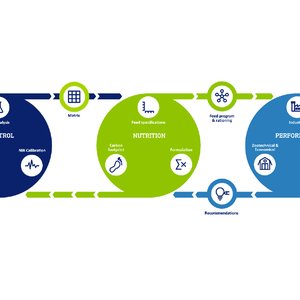EFSA Opinion says maximum concentration of methylmercury in farmed salmonids is approximately five times lower than EU maximum level for mercury in fish for human consumption
Summary
Mercury exists in the environment as elemental mercury (metallic), inorganic mercury and organic mercury (primarily methylmercury). Elemental and inorganic mercury released into the air from mining, smelting, industrial activities, combustion of fossil fuels, is deposited to soil, water and thereby to sediments where the mercury is transformed into methylmercury.
Methylmercury bioaccumulates and biomagnifies along the food chain, particularly in the aquatic food chain; longlived carnivorous fish and marine mammals exhibiting the highest contents. The toxicity and toxicokinetics of mercury in animals and humans depends on its chemical form.
Elemental mercury is volatile and mainly absorbed through the respiratory tract, whereas its absorption through the gastrointestinal tract is negligible. Gastrointestinal absorption of inorganic mercury is in the 10-30% range. Following absorption, inorganic mercury distributes mainly to the kidneys and, to a lesser extent, to the liver. The critical effect of inorganic mercury is renal damage.
In animals, as in humans, methylmercury and its salts are readily absorbed in the gastrointestinal tract (>80%). Absorbed methylmercury is widely distributed to all tissues, although the largest deposition occurs in the kidney. Excretion of unchanged methylmercury occurs predominantly in the faeces through biliary excretion. The enterohepatic cycle results in a long half-life for this compound compared to inorganic mercury. Methylmercury is able to cross the blood-brain and the placental barriers. As a consequence, the nervous system is the primary site of toxicity in animals and humans. In humans, effects on neurological development have been observed in children of mothers orally exposed to methylmercury. Animal studies confirmed these neurodevelopmental effects in foetus of dams exposed to methylmercury in the diet.
A substantial number of feed materials have been analysed for total mercury in recent years within the EU Member States, and for the large majority, the concentrations were below the maximum level specified in the feedingstuffs legislation.
The most common source of mercury in feed materials is fishmeal, however, in this category, no sample exceeded the maximum level of 0.5 mg/kg. In contrast, approximately 8% of the complete feedingstuffs for fish exceeded the maximum level of 0.1 mg/kg. The relatively few data available on the speciation of mercury in fishmeals indicate that it is mainly present as methylmercury.
The most sensitive domestic animal species to methylmercury toxicity are cats and mink. Based on the available data on the occurrence of total mercury in feed materials and complete feedingstuffs, it is unlikely that these species will be exposed to toxic levels.
The maximum concentration reported in farmed salmonids is approximately five times lower than the EU maximum level for mercury in fish for human consumption (500 µg/kg for salmonids). This mercury concentration in salmonids would allow weekly consumption of two fish meals, as recommended by nutritionists, without appreciable health risk.
The maximum level for fish feed is sufficient to ensure that contamination levels in farmed salmonids pose no appreciable risk to consumers, but the validity of the maximum level need to be ascertained for other farmed fish.
Scientific Opinions: Mercury as undesirable substance in animal feed - Scientific opinion of the Panel on Contaminants in the Food Chain Question number: EFSA-Q-2005-288 Full text of Opinion (PDF)










